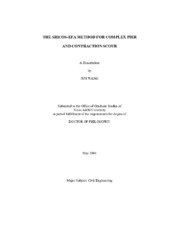| dc.contributor.advisor | Briaud, Jean-Louis | |
| dc.creator | Wang, Jun | |
| dc.date.accessioned | 2004-09-30T01:56:53Z | |
| dc.date.available | 2004-09-30T01:56:53Z | |
| dc.date.created | 2006-05 | |
| dc.date.issued | 2004-09-30 | |
| dc.identifier.uri | https://hdl.handle.net/1969.1/392 | |
| dc.description.abstract | A method called SRICOS-EFA is presented in this dissertation for scour prediction. The method is based on the calculation of two basic parameters: the maximum depth of scour and the initial rate of scour. The maximum depth of scour is based on an equation obtained from flume tests and the initial rate is based on an equation giving the initial shear stress obtained from numerical simulations. The initial scour rate is then read on the Erosion Function Apparatus (EFA) erosion function curve at the corresponding value of the calculated shear stress. A hyperbola is used to connect the initial scour rate to the maximum scour depth and describes the complete scour depth vs. time curve. The erodibility function curve can be measured in the EFA. As the results show, the SRICOS-EFA method can handle the multi-flood hydrograph and multilayer soil system. It can be used to solve the complex pier and contraction scour alone; it can also handle the superposition of complex pier scour and contraction scour. A simplified SRICOS-EFA method was developed based on the case histories for contraction scour. EFA tests were performed to investigate the influence of different pH values and different levels of salinity on the soil erodibility. An attempt was made to find the correlation between the critical shear stress, and the initial slope of the erodibility function on the one hand and some geotechnical parameters on the other. A solution for future hydrograph prediction was developed in this dissertation. The prediction consists of using a past hydrograph, preparing the frequency distribution plot for the daily stream flows, sampling the distribution randomly and preparing a future hydrograph, which has the same mean and standard deviation as the measured hydrograph. A frequency distribution plot of scour depths can be used to quote a scour depth with a corresponding probability of occurrence and risk level based on future hydrographs. In the verification process, 10 bridge case histories and 3 scour databases were used to check whether the method is good enough to provide sound results in real cases. | en |
| dc.format.extent | 9424861 bytes | en |
| dc.format.extent | 461447 bytes | en |
| dc.format.medium | electronic | en |
| dc.format.mimetype | application/pdf | |
| dc.format.mimetype | text/plain | |
| dc.language.iso | en_US | |
| dc.publisher | Texas A&M University | |
| dc.subject | Scour | en |
| dc.subject | SRICOS | en |
| dc.subject | EFA | en |
| dc.subject | Pier | en |
| dc.subject | Contraction | en |
| dc.title | The SRICOS-EFA method for complex pier and contraction scour | en |
| dc.type | Book | en |
| dc.type | Thesis | en |
| thesis.degree.department | Civil Engineering | en |
| thesis.degree.discipline | Civil Engineering | en |
| thesis.degree.grantor | Texas A&M University | en |
| thesis.degree.name | Doctor of Philosophy | en |
| thesis.degree.level | Doctoral | en |
| dc.contributor.committeeMember | Chang, Kuang-An | |
| dc.contributor.committeeMember | Chen, Hamn-Ching | |
| dc.contributor.committeeMember | Byant, William | |
| dc.type.genre | Electronic Dissertation | en |
| dc.type.material | text | en |
| dc.format.digitalOrigin | born digital | en |


